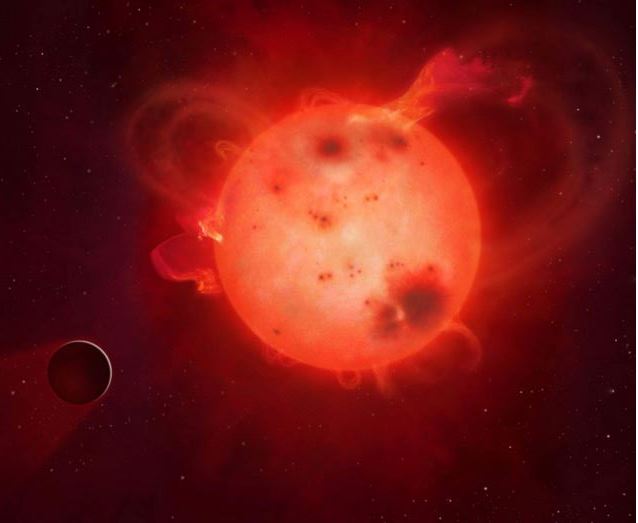The majority of Earth-like exoplanets are likely to have become uninhabitable due to the enormous quantities of radiation emitted from superflares, scientists from the University of Warwick in England informed. An exoplanet is a planet outside our Solar System that orbits a star.
The researchers published their findings in the academic journal Monthly Notices of the Royal Astronomical Society.
The atmosphere of Kepler-438b, which NASA confirmed was an exoplanet on 6 January, 2015, is believed to have been completely stripped away because of radiation emitted from a superflaring from Kepler-438, a Red Dwarf star.
 Kepler-438b in front of its violent parent star, Kepler-438. (Image credit: Mark A. Garlick / University of Warwick)
Kepler-438b in front of its violent parent star, Kepler-438. (Image credit: Mark A. Garlick / University of Warwick)
What are superflares?
Superflares are extremely powerful explosions observed on solar-like stars, believed to have energy production rates one million times greater than that of a typical solar flare.
These superflares, which occur every few hundred days, are about ten times more powerful than anything recorded on our Sun, and equivalent to the energy released from 100 billion megatons of TNT.
The superflares themselves are not thought to have had any serious effect on the atmosphere of Kepler-438. However, a dangerous phenomenon linked to these powerful flares, called CMA (coronal mass ejection), can strip away any atmosphere and render it inhospitable for any kind of life as we know it.
Kepler-438 is the most Earth-like exoplanet we know of
Of all the exoplanets discovered so far, Kepler-438 has the highest Earth Similarity Index, i.e. it is the most similar to our planet in terms of size and temperature. However, it is much closer to its star, a Red Dwarf, than we are to the Sun. A Red Dwarf is a small and relatively cool star.
Team leader, Dr. David Armstrong, who works at the university’s Astrophysics Group, explained:
“Unlike the Earth’s relatively quiet sun, Kepler-438 emits strong flares every few hundred days, each one stronger than the most powerful recorded flare on the Sun. It is likely that these flares are associated with coronal mass ejections, which could have serious damaging effects on the habitability of the planet.”
“If the planet, Kepler-438b, has a magnetic field like the Earth, it may be shielded from some of the effects. However, if it does not, or the flares are strong enough, it could have lost its atmosphere, be irradiated by extra dangerous radiation and be a much harsher place for life to exist.”
Life as we know it needs an atmosphere
Chloe Pugh, of the University of Warwick’s Centre for Fusion, Space and Astrophysics, said regarding the impact of the superflares and radiation on Kepler-438b’s atmosphere:
“The presence of an atmosphere is essential for the development of life. While flares themselves are unlikely to have a significant impact on an atmosphere as a whole, there is another more dangerous phenomenon associated with powerful flares, known as a coronal mass ejection.”
“Coronal mass ejections are where a huge amount of plasma is hurled outwards from the Sun, and there is no reason why they should not occur on other active stars as well. The likelihood of a coronal mass ejection occurring increases with the occurrence of powerful flares, and large coronal mass ejections have the potential to strip away any atmosphere that a close-in planet like Kepler-438b might have, rendering it uninhabitable.”
“With little atmosphere, the planet would also be subject to harsh UV and X-ray radiation from the superflares, along with charged particle radiation, all of which are damaging to life.”
Citation: The article has not yet appeared in Monthly Notices of the Royal Astronomical Society, but an Abstract appears at arXiv.org ahead of time. “The Host Stars of Keplers Habitable Exoplanets: Superflares, Rotation and Activity,” D. J. Armstrong, C. E. Pugh, A.-M. Broomhall, D. J. A. Brown, M. N. Lund, H. P. Osborn, D. L. Pollacco. arXiv:1511.05306 [astro-ph.EP].
Video – Kepler-438b

